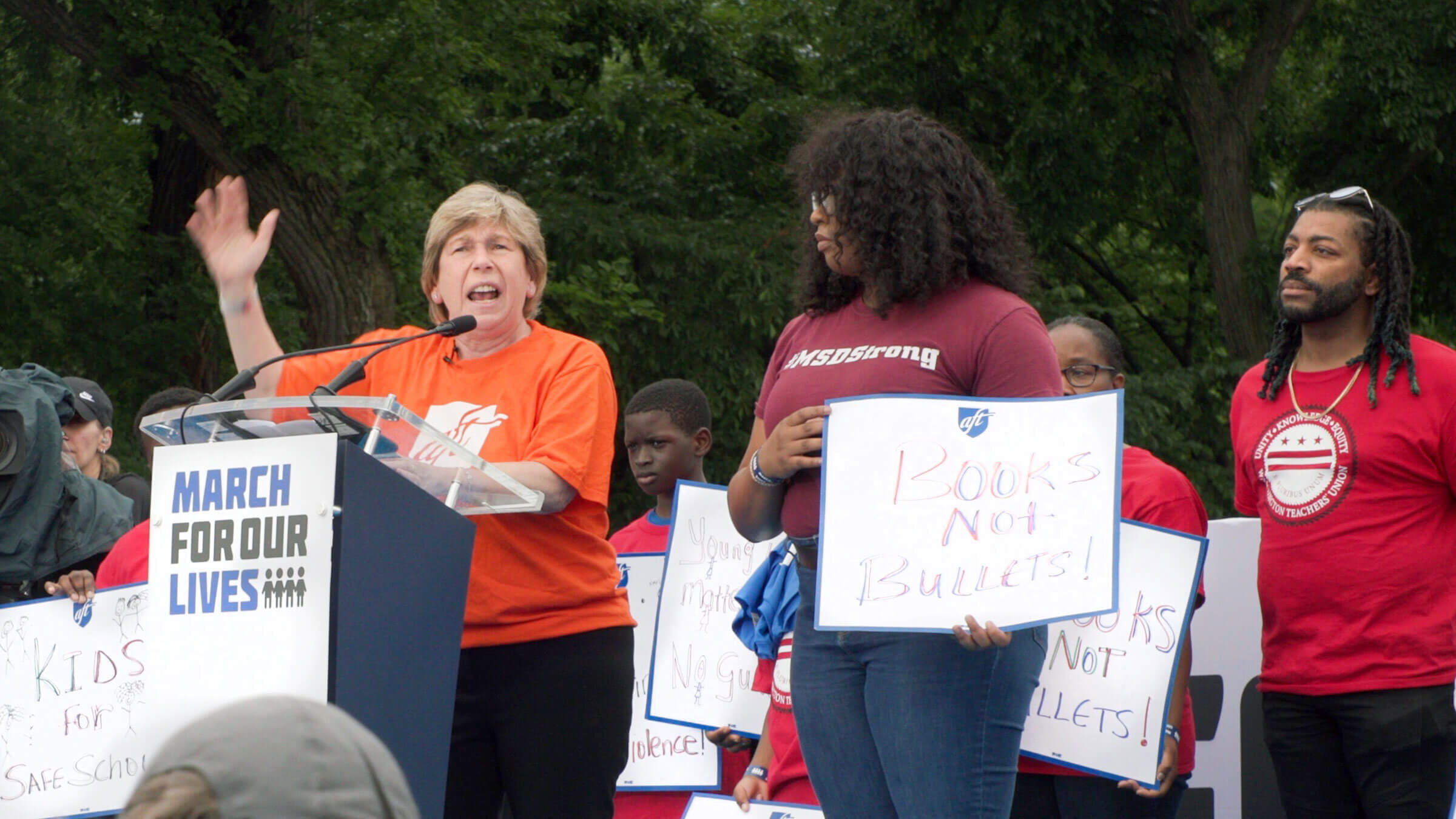Children under fire
We must end this uniquely American epidemic: the toxic combination of guns and hate.

Weingarten, with Mei-Ling Ho-Shing, Parkland, Fla., shooting survivor, addresses the March for Our Lives rally on the National Mall on June 11.
Columbine. Sandy Hook. Stoneman Douglas. Robb. Only in the United States are the names of so many children’s schools associated with gun massacres. Only here do students learn lockdown songs with lyrics like, “Go behind the desk and hide, wait until it’s safe inside.” Only here does a funeral home have to expedite an order of child-sized coffins for 19 children so mutilated by an assault weapon that they could only be identified by their parents’ DNA or the sneakers they were wearing when they were shot.
Children don’t have to personally experience gun violence to be traumatized by its specter. John Woodrow Cox, author of Children Under Fire: An American Crisis, says an estimated 4 million to 8 million students experience lockdowns in a single school year. Cox notes that “a meaningful number of those children thought, at least momentarily, that they might get shot to death in their school.” They text their parents goodbye. They write wills saying who they want their toys to go to. They soil themselves. Even drills can do unintended harm.
And it’s not just school shootings that are affecting our kids. It’s the unrelenting gun violence in places where we worship, shop or go to have fun, like dance clubs or movie theaters.
I was one of thousands of people at March for Our Lives rallies on the National Mall and in hundreds of communities across the United States. Thousands of teachers and school staff joined students, parents, community members and allies to demand an end to this uniquely American epidemic: the toxic combination of guns and hate that takes the lives of more than 100 people in this country every day in mass shootings, homicides, suicides, domestic violence and accidental gun deaths.
While schools still are among the safest places for children, the tragedy in Uvalde, Texas, was the 27th school shooting this school year, resulting in 83 people killed or injured so far. There is no acceptable amount of gun violence in schools. Period. Lawmakers who won’t do anything to reduce gun violence in schools should not make our laws.
As David Hogg, a survivor of the Parkland, Fla., school shooting and a founder of March for Our Lives, says, “This time must be different.” And there are signs it could be. Last Saturday we marched, and on Sunday a bipartisan group of senators acted on the first significant gun safety legislation in more than three decades.
This legislative proposal is not perfect. But, at this time of crisis, the standard should not be “is this everything we want?” but “will this save lives?” This bipartisan Senate framework is a promising start—and must be approved by Congress and signed into law as quickly as possible.
We will keep fighting for measures that were in the House bill and that huge majorities of Americans support, such as universal background checks, red-flag laws, safe storage provisions and bans on high-capacity magazines. As Stacey Abrams said at the AFL-CIO convention this week, “We can protect the Second Amendment and protect second-graders.”
But one thing we should never do is arm teachers. The tragedies in Uvalde and Buffalo showed that “good guys with a gun” don’t stop bad guys with a gun. The chance of a gun kept in a classroom accidentally shooting an innocent victim is far greater than the likelihood of a teacher taking out an assailant with an AR-15 and body armor. We need fewer guns in schools, not more of them. Arm schools instead with the necessary resources, counselors and nurses.
Ironically, many of those advocating for educators to carry guns in the classroom are the ones saying they don’t trust professional educators to pick out appropriate books or curriculum. Do they really have more confidence in teachers to kill an assailant than to educate students?
Schools should be sanctuaries, not fortresses. They should be places where everyone feels safe and welcome. Not one more student, not one more educator, not one more community should be ravaged by the horror of gun violence. On this, the vast majority of Americans agree. We must bridge our divisions for the common good, especially for our children.
I am an optimist. I believe in America and believe America can be better. My optimism was renewed as I marched with thousands of others last Saturday. Teachers depleted from the toughest year of their professional lives were visibly inspired. We were led by young people who have been failed by previous generations—young people who clearly will not cease until they succeed. And neither will we.












